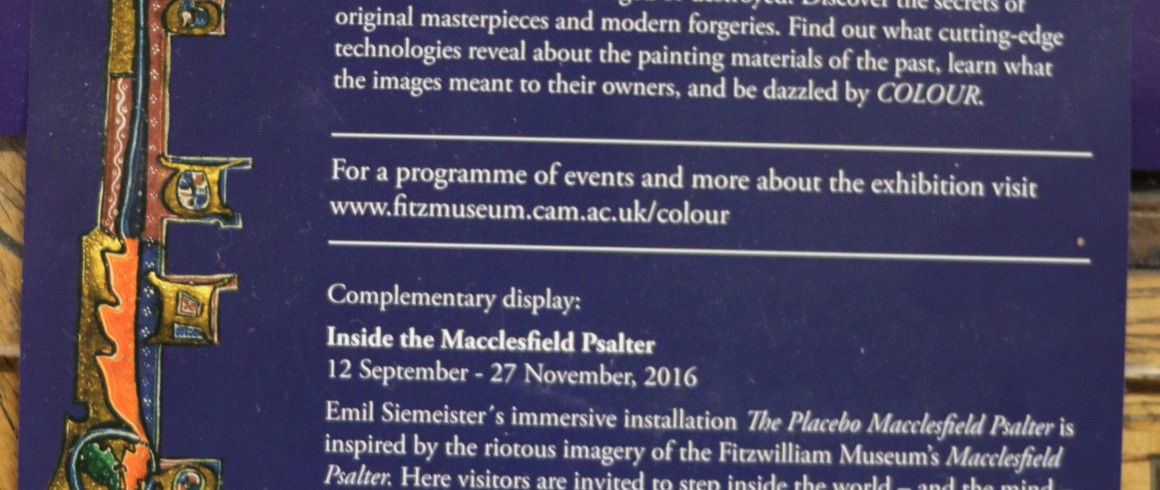Vibrant, mesmerizing, and enchanting: 'Colour' at the Fitzwilliam Museum
Colour: The Art and Science of Illuminated Manuscripts. 31 July 2016 – 2 January 2017 The Fitzwilliam Museum, Cambridge 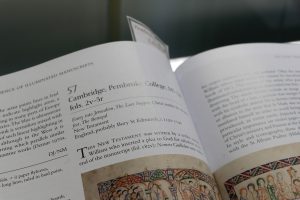 by guest author Stephanie Azzarello The English language has hundreds of words to describe different colours. Within the primary spectrum of Red, Orange, Yellow, Green, Blue, Purple, Black, and White, there exists—for each colour—myriad terms for subsequent shades: rust, rose, lilac, fuchsia, fern, olive, sky, ocean, plum, cream, butter, but to name only a few. The current exhibition, at the Fitzwilliam Museum, opens the door to a deep and mesmerizing exploration of colours vis-à-vis manuscript illuminations from the Middle Ages and Renaissance. Colour: The Art and Science of Illuminated Manuscripts is part of the Fitzwilliam Museum’s Bicentenary celebration and has been in the works for several years. I met the curator—Dr. Stella Panayotova (Keeper of Manuscripts and Printed Books)—in 2013, when she was the Distinguished Visiting Scholar at the Centre for Medieval Studies, University of Toronto. At the time, she was there to undertake some research for MINIARE—an international project that seeks to use non-invasive technologies for data collection and conservation of manuscripts. This research would also eventually become part of the Colour exhibition. Back in 2013, an exhibition opening in 2016 seemed a long way into the future, but after seeing the show in its scale and grandeur it is understandable that it was years in the making. There are 150 manuscripts on display in the Colour exhibition, as well as numerous individual manuscript leaves. The exhibition features manuscripts held in Fitzwilliam’s collection, the University Library, and also some which belong to various colleges, such as the magnificent Dover Bible (Cambridge, Corpus Christi College, MS 4), which is a massive two-volume masterpiece painted in Canterbury ca. 1150 -1160, and is a must-see item in this exhibition.
by guest author Stephanie Azzarello The English language has hundreds of words to describe different colours. Within the primary spectrum of Red, Orange, Yellow, Green, Blue, Purple, Black, and White, there exists—for each colour—myriad terms for subsequent shades: rust, rose, lilac, fuchsia, fern, olive, sky, ocean, plum, cream, butter, but to name only a few. The current exhibition, at the Fitzwilliam Museum, opens the door to a deep and mesmerizing exploration of colours vis-à-vis manuscript illuminations from the Middle Ages and Renaissance. Colour: The Art and Science of Illuminated Manuscripts is part of the Fitzwilliam Museum’s Bicentenary celebration and has been in the works for several years. I met the curator—Dr. Stella Panayotova (Keeper of Manuscripts and Printed Books)—in 2013, when she was the Distinguished Visiting Scholar at the Centre for Medieval Studies, University of Toronto. At the time, she was there to undertake some research for MINIARE—an international project that seeks to use non-invasive technologies for data collection and conservation of manuscripts. This research would also eventually become part of the Colour exhibition. Back in 2013, an exhibition opening in 2016 seemed a long way into the future, but after seeing the show in its scale and grandeur it is understandable that it was years in the making. There are 150 manuscripts on display in the Colour exhibition, as well as numerous individual manuscript leaves. The exhibition features manuscripts held in Fitzwilliam’s collection, the University Library, and also some which belong to various colleges, such as the magnificent Dover Bible (Cambridge, Corpus Christi College, MS 4), which is a massive two-volume masterpiece painted in Canterbury ca. 1150 -1160, and is a must-see item in this exhibition.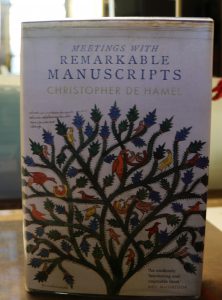 The aim of Colour was not merely to demonstrate that Cambridge is one of best places on earth to see manuscripts. According to Dr. Deidre Jackson—an art historian at the Fitzwilliam and one of the key people involved in Colour—this exhibition is about telling the story of the Fitzwilliam’s collection of illuminated codices vis-à-vis the medium of colour. But this story cannot be told in isolation and it required that other manuscripts, from other collections in the world, be brought in to complement the ones at the Fitz. Such volumes as the Göttingen Model Book (Göttingen, Niedersächsishe Staatsund Universitätsbibliothek, 8° Cod. MS Uffenb. 51 Cim), produced in Mainz ca. 1440-1460, demonstrate drawing exercises for illuminators, and fols. 2v – 3r describe a step-by-step guide for painting coloured acanthus leaves. This manuscript works to reinforce the didactic aspect of Colour, which seeks to convey to the audience that illuminators required highly specialized knowledge for using colour in medieval and Renaissance manuscripts. There are also some local gems on display: the Macclesfield Psalter (Fitzwilliam Museum, MS 1 – 2005), is an enchanting book produced in East Angelia, probably Norwich, ca. 1330 – 1340. The highly detailed scenes display complex and vibrantly colourful marginalia that had its genesis in this region but eventually became influential in areas outside of East Anglia. These masterpieces of medieval and Renaissance miniature painting rest gently on clear Plexiglas cradles in vitrines, which creates the illusion that these luxurious wonders are floating in the air. Framed along the walls there are also individual cuttings that have been excised from their original codicological context. These objects include: large-scale leaves of music such as the Creation of heaven and earth (Fitzwilliam Museum, MS 197), taken from an Antiphoner made in Siena ca. 1460 -1470; a series of delicate historiated initials featuring St Clement, St. Laurence, and Christ the Redeemer (MS 5-1979, Marlay cutting It. 13.i, 13.ii) excised from musical manuscripts painted in Florence in the late fourteenth/early-mid fifteenth centuries; and a lavish scene of the Last Supper (Fitzwilliam Museum, MS McClean 201.17) painted by Cristoforo Cortes in Venice ca. 1425- 1435. There is, also, the decadently massive Alchemical scroll (Fitzwilliam Museum, MS 276*) located at the very beginning of the exhibition, which greets visitors in a silent, majestic manner.
The aim of Colour was not merely to demonstrate that Cambridge is one of best places on earth to see manuscripts. According to Dr. Deidre Jackson—an art historian at the Fitzwilliam and one of the key people involved in Colour—this exhibition is about telling the story of the Fitzwilliam’s collection of illuminated codices vis-à-vis the medium of colour. But this story cannot be told in isolation and it required that other manuscripts, from other collections in the world, be brought in to complement the ones at the Fitz. Such volumes as the Göttingen Model Book (Göttingen, Niedersächsishe Staatsund Universitätsbibliothek, 8° Cod. MS Uffenb. 51 Cim), produced in Mainz ca. 1440-1460, demonstrate drawing exercises for illuminators, and fols. 2v – 3r describe a step-by-step guide for painting coloured acanthus leaves. This manuscript works to reinforce the didactic aspect of Colour, which seeks to convey to the audience that illuminators required highly specialized knowledge for using colour in medieval and Renaissance manuscripts. There are also some local gems on display: the Macclesfield Psalter (Fitzwilliam Museum, MS 1 – 2005), is an enchanting book produced in East Angelia, probably Norwich, ca. 1330 – 1340. The highly detailed scenes display complex and vibrantly colourful marginalia that had its genesis in this region but eventually became influential in areas outside of East Anglia. These masterpieces of medieval and Renaissance miniature painting rest gently on clear Plexiglas cradles in vitrines, which creates the illusion that these luxurious wonders are floating in the air. Framed along the walls there are also individual cuttings that have been excised from their original codicological context. These objects include: large-scale leaves of music such as the Creation of heaven and earth (Fitzwilliam Museum, MS 197), taken from an Antiphoner made in Siena ca. 1460 -1470; a series of delicate historiated initials featuring St Clement, St. Laurence, and Christ the Redeemer (MS 5-1979, Marlay cutting It. 13.i, 13.ii) excised from musical manuscripts painted in Florence in the late fourteenth/early-mid fifteenth centuries; and a lavish scene of the Last Supper (Fitzwilliam Museum, MS McClean 201.17) painted by Cristoforo Cortes in Venice ca. 1425- 1435. There is, also, the decadently massive Alchemical scroll (Fitzwilliam Museum, MS 276*) located at the very beginning of the exhibition, which greets visitors in a silent, majestic manner. 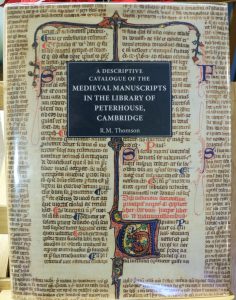 While Colour is certainly a kaleidoscopic feast for the eyes, there is an intellectual component that is rooted in MINIARE’s pursuit of the scientific aspect of manuscript studies. The exhibition aims to educate people about the technical side of painting through the exploration of colours in their most pure form: pigments. The exhibition is laid out in in two adjoining rooms and broken up further into sections based on themes such as ‘precious medals,’ ‘modelling,’ and ‘colour theory/optics’—mirroring the same chapter demarcation found in the exhibition catalogue. Upon entering, visitors can see a wall display that showcases the organic materials, in both their raw and refined states, that are used to make pigments. The bright reds, greens, blues, and yellows found in the manuscript illuminations on display are the product of labour-intensive processes rooted in alchemy. By reading the panel descriptions on the walls of the exhibition, one learns that raw materials, such as bone, lead, copper, and lapis lazuli—only to name a few—are crushed, heated, and sometimes mixed with other substances, in order to transform them into a liquid state: paint. Right beside that, there is a wall map showing the diverse locations from which all these raw materials originate, and the trade routes along which they would have travelled during the Middle Ages and Renaissance. Colour has also employed the use of technology within the exhibition to make this material even more accessible to visitors. Just before one enters the second room of the exhibit, there is a row of wall-mounted computer screens that visitors can use to digitally interact with the manuscripts. By using this tool, visitors can find out more specific details about certain manuscripts on display; can see multiple pages of a single volume; and can zoom in closely to get a better look at the images. Pembroke College has several connections to this amazing exhibition. The college has graciously lent one of our manuscripts to be put on display: a New Testament (Cambridge, Pembroke College, MS 120), probably painted at Bury St. Edmund’s ca. 1130 – 1140. The manuscript is opened to fols. 2v – 3r, which are facing pages that show several scenes from the life of Christ: Entry into Jerusalem, the Last Supper, Christ washes his disciples feet, and The Betrayal. A scribe called William, who inserted a plea for his own salvation, wrote the book. The artists who painted this volume are unknown. The images are drawn in brown ink and brightly coloured with red, blue, green, and brown ink. The illuminators employed a style of painting termed ‘tinted drawing,’ called so because the coloured pigments are not applied to the entire surface of the figure, creating a shaded, tinted effect. This technique was first seen in the Anglo-Saxon manuscripts of the tenth and eleventh centuries. The manuscript came into the possession of the College in late 1670s.
While Colour is certainly a kaleidoscopic feast for the eyes, there is an intellectual component that is rooted in MINIARE’s pursuit of the scientific aspect of manuscript studies. The exhibition aims to educate people about the technical side of painting through the exploration of colours in their most pure form: pigments. The exhibition is laid out in in two adjoining rooms and broken up further into sections based on themes such as ‘precious medals,’ ‘modelling,’ and ‘colour theory/optics’—mirroring the same chapter demarcation found in the exhibition catalogue. Upon entering, visitors can see a wall display that showcases the organic materials, in both their raw and refined states, that are used to make pigments. The bright reds, greens, blues, and yellows found in the manuscript illuminations on display are the product of labour-intensive processes rooted in alchemy. By reading the panel descriptions on the walls of the exhibition, one learns that raw materials, such as bone, lead, copper, and lapis lazuli—only to name a few—are crushed, heated, and sometimes mixed with other substances, in order to transform them into a liquid state: paint. Right beside that, there is a wall map showing the diverse locations from which all these raw materials originate, and the trade routes along which they would have travelled during the Middle Ages and Renaissance. Colour has also employed the use of technology within the exhibition to make this material even more accessible to visitors. Just before one enters the second room of the exhibit, there is a row of wall-mounted computer screens that visitors can use to digitally interact with the manuscripts. By using this tool, visitors can find out more specific details about certain manuscripts on display; can see multiple pages of a single volume; and can zoom in closely to get a better look at the images. Pembroke College has several connections to this amazing exhibition. The college has graciously lent one of our manuscripts to be put on display: a New Testament (Cambridge, Pembroke College, MS 120), probably painted at Bury St. Edmund’s ca. 1130 – 1140. The manuscript is opened to fols. 2v – 3r, which are facing pages that show several scenes from the life of Christ: Entry into Jerusalem, the Last Supper, Christ washes his disciples feet, and The Betrayal. A scribe called William, who inserted a plea for his own salvation, wrote the book. The artists who painted this volume are unknown. The images are drawn in brown ink and brightly coloured with red, blue, green, and brown ink. The illuminators employed a style of painting termed ‘tinted drawing,’ called so because the coloured pigments are not applied to the entire surface of the figure, creating a shaded, tinted effect. This technique was first seen in the Anglo-Saxon manuscripts of the tenth and eleventh centuries. The manuscript came into the possession of the College in late 1670s.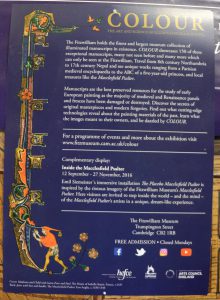 In honour of our contribution to the Colour exhibition, our college librarian Patricia Aske has curated a small ‘exhibit’ in the front foyer of the library. Aske has used the Colour catalogue as the centrepiece—opened to the entry on our manuscript—around which she has gathered other elements germane to the theme. One can see various posters advertising the Colour exhibition, a book on the topic of colour and pigments, and a hardbound volume dedicated to manuscripts in the Cambridge collections. Another way in which Pembroke is directly linked to the Colour exhibition is that the author of this article has the good fortune of being supervised by the curator, Dr. Panayotova. As a third-year PhD candidate in the History of Art faculty my work focuses on the reconstruction of a now-dismembered series of illuminated choir books made for the Camaldolese monasteries of San Michele and San Mattia a Murano, near Venice. Dr. Panayotova’s work on the topic of colour has, naturally, greatly influenced my own research. Additionally, one cutting from my corpus is on display in the exhibition: Dormition of the Virgin (Fitzwilliam Museum, Marlay cutting It. 18). This elegant historiated initial G, painted by the so-called Master of the Murano Gradual, ca. 1420, is in pristine quality and features the use of burnished gold, smalt (a blue-glass pigment) and delicate foliate decorations.
In honour of our contribution to the Colour exhibition, our college librarian Patricia Aske has curated a small ‘exhibit’ in the front foyer of the library. Aske has used the Colour catalogue as the centrepiece—opened to the entry on our manuscript—around which she has gathered other elements germane to the theme. One can see various posters advertising the Colour exhibition, a book on the topic of colour and pigments, and a hardbound volume dedicated to manuscripts in the Cambridge collections. Another way in which Pembroke is directly linked to the Colour exhibition is that the author of this article has the good fortune of being supervised by the curator, Dr. Panayotova. As a third-year PhD candidate in the History of Art faculty my work focuses on the reconstruction of a now-dismembered series of illuminated choir books made for the Camaldolese monasteries of San Michele and San Mattia a Murano, near Venice. Dr. Panayotova’s work on the topic of colour has, naturally, greatly influenced my own research. Additionally, one cutting from my corpus is on display in the exhibition: Dormition of the Virgin (Fitzwilliam Museum, Marlay cutting It. 18). This elegant historiated initial G, painted by the so-called Master of the Murano Gradual, ca. 1420, is in pristine quality and features the use of burnished gold, smalt (a blue-glass pigment) and delicate foliate decorations.
